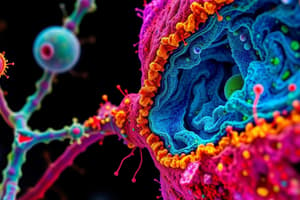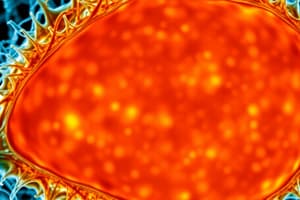Podcast
Questions and Answers
Who first observed cells in a cork using a light microscope?
Who first observed cells in a cork using a light microscope?
- Anton van Leeuwenhoek
- Louis Pasteur
- Robert Hooke (correct)
- Carl Zeiss
The maximum magnification of a light microscope is x2,000,000.
The maximum magnification of a light microscope is x2,000,000.
False (B)
What are the two types of electron microscopes?
What are the two types of electron microscopes?
Scanning electron microscope (SEM) and transmission electron microscope (TEM)
The resolving power of a light microscope is approximately _____ nm.
The resolving power of a light microscope is approximately _____ nm.
Which part of the light microscope produces a magnified image?
Which part of the light microscope produces a magnified image?
Electrons are used in electron microscopes because they have a much smaller wavelength than _______.
Electrons are used in electron microscopes because they have a much smaller wavelength than _______.
Match the following magnification and resolving power to the appropriate microscope type:
Match the following magnification and resolving power to the appropriate microscope type:
Light microscopes can view deep inside sub-cellular structures.
Light microscopes can view deep inside sub-cellular structures.
Flashcards
What is the purpose of a microscope?
What is the purpose of a microscope?
Microscopes use lenses to magnify tiny objects that are too small to be seen with the naked eye.
Who first observed cells?
Who first observed cells?
Robert Hooke was the first scientist to observe cells using a light microscope. He used a cork to conduct his experiment.
How does a light microscope magnify an image?
How does a light microscope magnify an image?
A light microscope uses two lenses: an objective lens and an eyepiece lens. The objective lens creates a magnified image, which is then further magnified by the eyepiece.
What is resolving power?
What is resolving power?
Signup and view all the flashcards
How does an electron microscope work?
How does an electron microscope work?
Signup and view all the flashcards
What are the two types of electron microscopes?
What are the two types of electron microscopes?
Signup and view all the flashcards
How do you calculate the magnification of a light microscope?
How do you calculate the magnification of a light microscope?
Signup and view all the flashcards
How do you calculate the size of an object viewed under a microscope?
How do you calculate the size of an object viewed under a microscope?
Signup and view all the flashcards
Study Notes
Microscopy
- Extremely small structures, like cells, are invisible without magnification. Microscopes enlarge images.
- Robert Hooke observed cork cells in 1665 using a light microscope.
- A light microscope has two lenses: objective and eyepiece.
- The objective lens magnifies the image, which is further magnified by the eyepiece.
- Light microscopes are typically illuminated from underneath.
- Light microscopes have a maximum magnification of approximately x2000 and a resolving power of 200nm. Resolving power determines the ability to distinguish between two points.
- Scientists used light microscopes in the 1930s to view cells and larger subcellular structures.
- Electron microscopes use electrons instead of light to create images.
- Electrons have a much shorter wavelength than light waves, allowing for higher resolution.
- Electron microscopes produce significantly higher resolution images than light ones.
- Electron microscope types include scanning electron microscopes (SEM) and transmission electron microscopes (TEM).
- SEM creates 3D images with slightly lower magnification. TEM produces 2D images with higher magnification, focusing on details within organelles.
- SEM has a magnification up to x2,000,000 and a resolving power of 10nm.
- TEM has a magnification up to x2,000,000 and a resolving power of 0.2nm.
- Common calculations for Microscopy include magnification (eyepiece lens magnification x objective lens magnification), and determining object size (image size / magnification = object size).
Studying That Suits You
Use AI to generate personalized quizzes and flashcards to suit your learning preferences.




